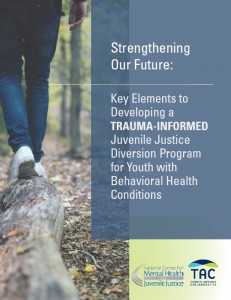By Bridget Murphy, February 25 2016
Trauma - a six letter word that carries a lot of significance. Depending on your education and experiences the word brings different thoughts, feelings, and reactions. It is a topic that has received a lot of recognition in the past few decades and is comprehensively described in a publication recently released by the National Center for Mental Health and Juvenile Justice  (NCMHJJ). Strengthening Our Future: Key Elements to Developing a Trauma Informed Juvenile Justice Diversion Program for Youth with Behavioral Health Conditions provides necessary background and implementation practices for those working in the juvenile justice system. One aspect I found very helpful was the concrete examples of how jurisdictions have operationalized implementation practices. For example, a case example from Indiana is provided on page 21. As a way to be trauma-informed - Indiana took a procedural approach. More specifically, Indiana started by reviewing and selecting an assessment, integrated it into the electronic information technology system, supplemented the assessment with a trauma specific assessment, and providing training for personnel working within juvenile justice. This publication is a useful resource that can assist in the development of policies and procedures, practices, and training.
(NCMHJJ). Strengthening Our Future: Key Elements to Developing a Trauma Informed Juvenile Justice Diversion Program for Youth with Behavioral Health Conditions provides necessary background and implementation practices for those working in the juvenile justice system. One aspect I found very helpful was the concrete examples of how jurisdictions have operationalized implementation practices. For example, a case example from Indiana is provided on page 21. As a way to be trauma-informed - Indiana took a procedural approach. More specifically, Indiana started by reviewing and selecting an assessment, integrated it into the electronic information technology system, supplemented the assessment with a trauma specific assessment, and providing training for personnel working within juvenile justice. This publication is a useful resource that can assist in the development of policies and procedures, practices, and training.
The National Child Traumatic Stress Network (NCTSN) provides 13 definitions for different types of trauma from community violence to traumatic grief. These definitions underscore the breadth and depth of the possible types of trauma young people and families might experience. As the NCMHJJ publication points out - individuals, families, and communities respond to traumatic events differently due to a variety of factors (e.g., neurological; biological; social; cultural). Consequently, two individuals could have been exposed to the same traumatic experience, but respond in very different ways. The NCMHJJ publication details the significance of and practices for engaging and involving youth which is key to determining how (if at all) a young person responds to traumatic events. The publication states the importance of youth voice by creating a safe and supportive atmosphere, allowing youth to tell their own story, building and supporting positive interactions, and engaging family, including non-traditional family (a youth’s family of choice) (pp. 24-25).
One important type of trauma that both the NCMHJJ publication and NCTSN touch on, but I think needs further elaboration is “historical trauma.” This is particularly relevant to youth and families involved in the juvenile justice system given the over-representation of youth of color.
Historical trauma has been defined as the: “cumulative and psychological wounding over the life span and across generations, emanating from massive group trauma experience.” -Brave Heart, 2005
Given the significance of historical trauma among juvenile justice involve youth we asked Tiana Davis, Policy Director for Equity and Justice at the Center of Children’s Law and Policy about ways juvenile justice practitioners might identify and create implementation strategies to address historical trauma. She said:
“Our legacy of racial discrimination and oppression has produced historical trauma that can deeply influence interactions between youth, families and communities of color and the justice system. Juvenile justice practitioners can only begin to address the tension and mistrust that result when they acknowledge the ongoing history of injustice, affirm its present impact, and work proactively and explicitly to change it.”
Ms. Davis’ comment calls for practitioners to be diligent and intentional in their efforts. To make informed decisions and take action regarding policies, procedures, and practices which lead to continued racial discrimination and oppression.
Equally important for us to acknowledge is the identification of cultural strengths that may improve a young person’s resilience to trauma. Cultural strengths such as the value of family, traditions, elders and extended family, spirituality and/or religiosity, and language help improve an individual’s resilience, feelings of hope, and coping when traumatic events occur. Also critical is the fact that these cultural strengths have helped to develop survival skills that have protected, sustained, and nurtured groups over time (e.g., race/ethnic; gender; religious/faith; sexual orientation).
I think having an understanding of and practices for addressing individual and historical trauma is critical for Reclaiming Futures sites. We work within stressful and potentially re-traumatizing environments which requires us to have a heightened awareness and practices for minimizing these effects. The NCMHJJ publication discusses the importance of cross-sector collaboration – a key component to the Reclaiming Futures approach and model. Utilizing the Fellowship team by incorporating a "champion” that advocates for and brings trauma informed practices to the jurisdiction might be one way to improve local systems and collaborations (NCMHJJ, pp. 15).
We would be interested to hear some other ways trauma-informed practices are being implemented at your site. Let us know….
Updated: January 08 2018
